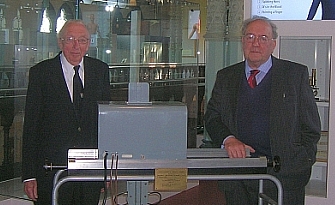Marking 50 Years of Ultrasound
Published: 5 June 2008
50 years ago a team of researchers in Glasgow published a scientific paper in the medical journal, The Lancet, which was to revolutionise medical diagnostics.
50 years ago, on the 8th June 1958, a team of researchers in Glasgow published a scientific paper in the medical journal, The Lancet, which was to revolutionise medical diagnostics.
Professor Ian Donald and Dr John McVicar, obstetricians at the Glasgow Western Infirmary, and Tom Brown an engineer with the Glasgow firm Kelvin Hughes were pioneers in the development and clinical application of ultrasound technology. 
Initially used in gynaecology for the detection and diagnosis of the nature of growths in the abdomen, the potential to reveal information on the growing foetus in the womb was soon realised and now ultrasound scanning is a routine part of pre-natal care. Indeed ultrasound scanning is used in most other branches of medicine and recent advances in technology have enabled real-time three dimensional scanning to develop.
The 1958 paper entitled ‘Investigation of abdominal masses by pulsed ultrasound’ described the results obtained by Donald, McVicar and Brown from scanning over 100 patients with the early prototype scanner which had been developed from industrial metal flaw detector technology. Courtesy of a loan from the British Medical Ultrasound Society, this early scanner is on show at the Hunterian Museum in the University of Glasgow as part of the ‘Healing Passion’ exhibition on medical history in the West of Scotland. The prototype scanner was assembled using all sorts of pieces of equipment, from a disused flaw detector to bits of Meccano and a hospital bed table. Tom Brown who built the scanner said that ‘It was a case of scrounging for parts wherever I could’. From this practical, low-cost but visionary start, all the sleek modern equipment now taken as standard followed.
The BBC will screen a programme to celebrate 60 years of the National Health Service towards the end of June and it will feature John McVicar and Tom Brown talking about their experiences in developing this most important clinical tool.
The Hunterian Museum is open from 9.30am - 5pm, Monday to Saturday. Admission is free. The exhibition ‘A Healing Passion: Medicine in Glasgow Past and Present’ is located on the upper balcony of the Museum main hall.
For further information contact:
Maggie Reilly, Curator, Hunterian Museum
Telephone 0141 330 4772 Email M.Reilly@museum.gla.ac.uk
For images contact:
Harriet Gaston, Publicity and Marketing Manager, Hunterian Museum and Art Gallery
Telephone 0141 330 3310 Email H.Gaston@museum.gla.ac.uk
Hunterian Museum
Gilbert Scott Building
University of Glasgow
Glasgow G12 8QQ
www.hunterian.gla.ac.uk
Image: (L - R) John McVicar and Tom Brown with the bed scanner in the Hunterian Museum
First published: 5 June 2008
<< June

